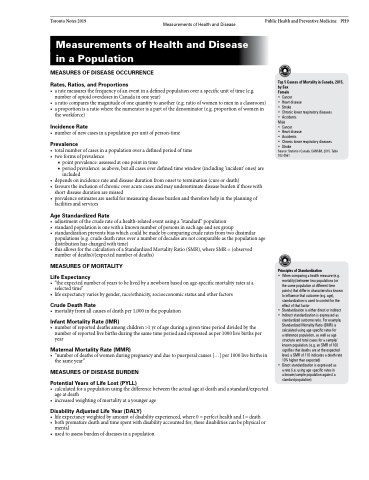Page 1227 - TNFlipTest
P. 1227
Toronto Notes 2019 Measurements of Health and Disease
Public Health and Preventive Medicine PH9
Measurements of Health and Disease
in a Population
MEASURES OF DISEASE OCCURRENCE
Rates, Ratios, and Proportions
• aratemeasuresthefrequencyofaneventinadefinedpopulationoveraspecificunitoftime(e.g. number of opioid overdoses in Canada in one year)
• aratiocomparesthemagnitudeofonequantitytoanother(e.g.ratioofwomentomeninaclassroom)
• aproportionisaratiowherethenumeratorisapartofthedenominator(e.g.proportionofwomenin
the workforce)
Incidence Rate
• numberofnewcasesinapopulationperunitofperson-time
Prevalence
• totalnumberofcasesinapopulationoveradefinedperiodoftime
• twoformsofprevalence
■ point prevalence: assessed at one point in time
■ period prevalence: as above, but all cases over defined time window (including ‘incident’ ones) are
included
• dependsonincidencerateanddiseasedurationfromonsettotermination(cureordeath)
• favourstheinclusionofchronicoveracutecasesandmayunderestimatediseaseburdenifthosewith
short disease duration are missed
• prevalenceestimatesareusefulformeasuringdiseaseburdenandthereforehelpintheplanningof
facilities and services
Age Standardized Rate
• adjustmentofthecruderateofahealth-relatedeventusinga“standard”population
• standardpopulationisonewithaknownnumberofpersonsineachageandsexgroup
• standardizationpreventsbiaswhichcouldbemadebycomparingcruderatesfromtwodissimilar
populations (e.g. crude death rates over a number of decades are not comparable as the population age
distribution has changed with time)
• thisallowsforthecalculationofaStandardizedMortalityRatio(SMR),whereSMR=(observed
number of deaths)/(expected number of deaths)
MEASURES OF MORTALITY
Life Expectancy
• “theexpectednumberofyearstobelivedbyanewbornbasedonage-specificmortalityratesata selected time”
• lifeexpectancyvariesbygender,race/ethnicity,socioeconomicstatusandotherfactors
Crude Death Rate
• mortalityfromallcausesofdeathper1,000inthepopulation
Infant Mortality Rate (IMR)
• numberofreporteddeathsamongchildren>1yrofageduringagiventimeperioddividedbythe number of reported live births during the same time period and expressed as per 1000 live births per year
Maternal Mortality Rate (MMR)
• “numberofdeathsofwomenduringpregnancyandduetopuerperalcauses[...]per1000livebirthsin the same year”
MEASURES OF DISEASE BURDEN
Potential Years of Life Lost (PYLL)
• calculatedforapopulationusingthedifferencebetweentheactualageatdeathandastandard/expected age at death
• increasedweightingofmortalityatayoungerage
Disability Adjusted Life Year (DALY)
• lifeexpectancyweightedbyamountofdisabilityexperienced,where0=perfecthealthand1=death
• bothprematuredeathandtimespentwithdisabilityaccountedfor;thesedisabilitiescanbephysicalor
mental
• usedtoassessburdenofdiseasesinapopulation
Top 5 Causes of Mortality in Canada, 2015, by Sex
Female
• Cancer
• Heart disease
• Stroke
• Chronic lower respiratory diseases
• Accidents
Male
• Cancer
• Heart disease
• Accidents
• Chronic lower respiratory diseases
• Stroke
Source: Statistics Canada. CANSIM, 2015. Table 102-0561
Principles of Standardization
• When comparing a health measure (e.g. mortality) between two populations (or the same population at different time points) that differ in characteristics known to influence that outcome (e.g. age), standardization is used to control for the effect of that factor
• Standardization is either direct or indirect
• Indirect standardization is expressed as
standardized outcome ratio. For example, Standardized Mortality Ratio (SMR) is calculated using age specific rates for
a reference population, as well as age structure and total cases for a sample/ known population. (e.g. an SMR of 100 signifies that deaths are at the expected level, a SMR of 110 indicates a death rate 10% higher than expected)
• Direct standardization is expressed as a rate (i.e. using age specific rates in a known/sample population against a standard population)


